When repotting bonsai, I try to keep roots exposed to air for as little time as possible. When I know what pot a tree will be planted in ahead of time, I’ll add wire and screen to the pot before I begin the rootwork. I knew I’d plant my sawara cypress into a terra cotta pot ahead of time so I began the process by adding screen and wire (2mm aluminum) to the pot.

Pot prepared
When I was finished with the rootwork, I started adding soil to the pot. I began with a drainage layer of pure pumice.
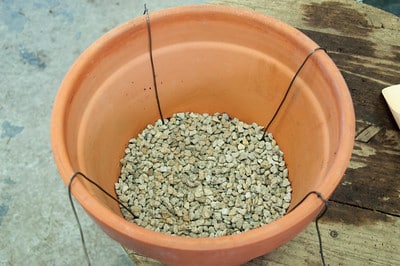
Pumice drainage layer
I then added some bonsai soil, creating a small mound on which I placed the rootball.
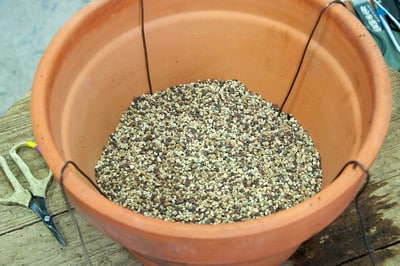
Bonsai soil in the bottom of the pot
Next comes the tricky process of setting the tree. Mound up too much soil and the surface roots will be exposed to the air. Mound up too little and the base of the trunk gets buried. Once the soil level is correct, I nestle the tree into place with a gentle twisting action. After the twisting, the tree should come to rest at the idea height, centered equidistant from all edges of the pot, and set at the proper planting angle.
This often requires more than one pass. If, after nestling the tree into the soil, the base of the trunk is too low, I remove the tree, add more soil, and repeat the process until I get the level right. I never mind taking my time with this stage as it’s far easier to correct mistakes here than it is once the tree is planted.
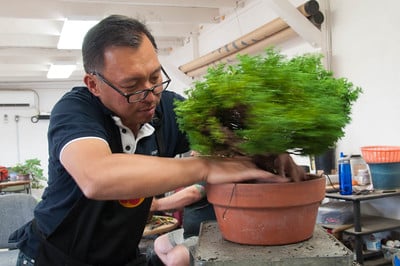
Boon gently twisting a dwarf sawara cypress into the pot
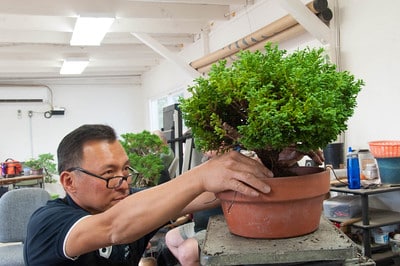
Checking the planted angle
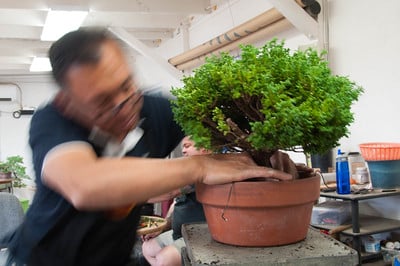
Making further adjustments
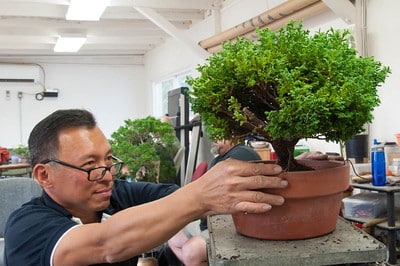
Once again checking the level
When planted at the appropriate level, I can fill the pot with enough soil to just cover the surface roots without filling the pot to the rim.
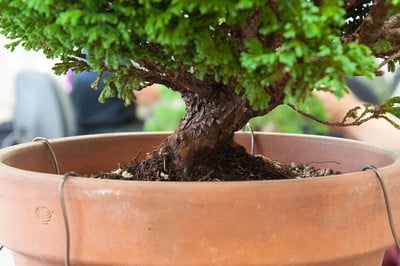
Tree set at the proper level
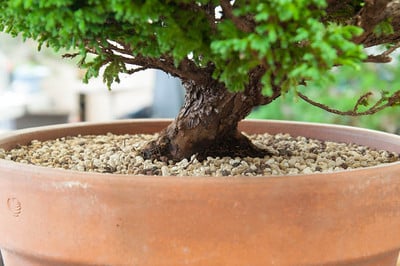
After adding bonsai soil
What about wiring the tree into the pot? Details next week.
Subscribe to Bonsai Tonight
New Posts Delivered Every Tuesday and Friday
Juan says
Dang, you are sure starting to look like Boon these days. What is it people say about starting to look like their pets……
Mac says
Good tutorial Jonas, thank you.
biervenskus says
I’ve been told that a ‘drainage level’ is not necessary, and sometimes can hold water. What is your opinion?
Jonas Dupuich says
Good question about the drainage layer. One way to look at this would be to look at comparative water retention rates of soil media and preferences of different varieties – approaches I have yet to study in any meaningful or controlled way. That said, the drainage layers I use, typically straight pumice or lava, consist of materials that don’t break down over time. Akadama and organic material do break down over time. The collection of smaller particles at the bottom of the pot can impede or block drainage. By using material that doesn’t break down, not only do I ensure that the drainage layer won’t contribute to the problem, but I provide a place for some of these particles to collect before they get to the drainage screen where I most want to maintain good drainage.
Brian says
Question
Doesn’t pumice break down before your akadama breaks down. If you are potting a cypress is it not for a long time. Say 4to5 years. I have been coming across the use of pumice as a base regularly , who started it and how long have bonsai people been useing it.
Jonas Dupuich says
The pumice I use doesn’t break down as it’s closer in durability to lava (http://bonsaitonight.com/tag/pumice/). I don’t know who started using it or for how long it has been used but it’s quite common across the US and, from what I’ve seen, Japan. (Boon Manakitivipart, among others, has done a lot to popularize its use across the US for at least roughly 15 years.)
The Japanese pumice is different from US pumice but functions in a similar manner. I’ve heard conflicting opinions about whether different pumices hold more or less water than other particles but can’t weigh in as I have yet to see any controlled (or close to it) approaches to determining this.
Thanks for the questions!
john brannon says
why are you potting into a terracotta container as opposed to say a plastic pot?
Jonas Dupuich says
Terracotta pots are closer to bonsai pots in that they breathe better than plastic and they hold their shape which is important when wiring trees into the pot.